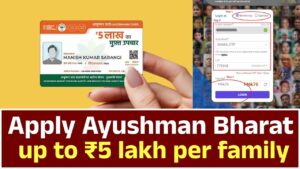Apply Ayushman Bharat
1. Introduction
Healthcare in India has always been a crucial challenge. With a population of over 1.4 billion, millions of families struggle with out-of-pocket medical expenses. According to studies, nearly 60% of Indians fall into poverty due to health costs. To solve this, the Government of India introduced the Ayushman Bharat – Pradhan Mantri Jan Arogya Yojana (AB-PMJAY) in 2018.

This scheme is popularly known as Modicare and is considered the world’s largest government-funded health assurance scheme. It provides cashless health insurance coverage of up to ₹5 lakh per family per year for secondary and tertiary care hospitalization, benefiting more than 50 crore (500 million) people.
2. Objective of the Scheme
The major goals of PMJAY are:
- To provide financial protection to poor and vulnerable families.
- To reduce catastrophic health expenditures.
- To ensure universal health coverage for India’s poor.
- To improve access to quality healthcare services in both government and private hospitals.
- To promote equity in healthcare access (removing inequality between rich and poor).
3. Eligibility
PMJAY targets the poorest and most vulnerable families. Eligibility is decided on the basis of Socio-Economic Caste Census (SECC) 2011 data and is linked with ration cards under the National Food Security Act.
Rural Beneficiaries
- Families living in one-room kucha houses.
- Families with no adult members (16–59 years).
- Families headed by women with no adult male.
- SC/ST households.
- Landless households depending on manual labor.
Urban Beneficiaries
- Families working as street vendors, rickshaw pullers, ragpickers, domestic workers, construction workers, sanitation workers, etc.
- Families with low-income ration cards.
Special Expansion (2024–25 update)
- From 2025, all senior citizens above 70 years are included, irrespective of ration card type.
- Senior citizens in PMJAY families also get an extra ₹5 lakh top-up health cover only for themselves.
4. Benefits of PMJAY
- Health Coverage
- ₹5 lakh per family per year.
- Covers hospitalization (secondary & tertiary care).
- Cashless & Paperless
- No upfront payment required.
- Beneficiaries can walk into empanelled hospitals.
- Portability
- Benefits can be availed in any empanelled hospital across India.
- Wide Treatment Coverage
- Covers over 1,500 medical packages (surgeries, treatment, medicines, diagnostics).
- Includes cardiology, oncology, orthopedics, nephrology, maternity, burns, etc.
- Pre-existing Conditions
- All pre-existing diseases covered from day one.
- No Cap on Family Size
- Entire family is covered.
- No restriction on age, gender, or number of members.
5. How PMJAY Works
- Funded jointly by the Central and State Governments.
- The National Health Authority (NHA) manages it at the central level.
- State Health Agencies (SHA) manage it at the state level.
- Hospitals are empanelled (both government and private) after meeting quality standards.
- Beneficiaries are identified using ration cards & Aadhaar verification.
6. Services Covered
PMJAY covers:
- Day-care treatments.
- Hospitalization expenses.
- Pre and post-hospitalization (3 days before and 15 days after).
- Diagnostics, lab tests, consultation, medicines.
- ICU services.
- Complications during treatment.
7. Services Not Covered
PMJAY does not cover:
- OPD consultations without hospitalization.
- Cosmetic surgery.
- Fertility treatments (IVF).
- Drug rehabilitation.
- Individual diagnostics outside hospitalization.
8. Application Process
Step 1: Check Eligibility
- Visit mera.pmjay.gov.in.
- Enter your ration card number / mobile number.
- Check if your family is eligible.
Step 2: Apply / Register
- If eligible, apply through:
- Common Service Centers (CSCs).
- Empanelled hospitals.
- Ayushman Mitra centers.
Step 3: Documents Required
- Ration card.
- Aadhaar card.
- Voter ID.
- Mobile number.
- Passport-size photos.
Step 4: Golden Card
- Once verified, you’ll get an Ayushman Bharat Golden Card.
- This card is used to access cashless treatment.
9. Hospitals Covered
- Government hospitals.
- Private hospitals (after empanelment).
- Over 28,000 hospitals empanelled across India.
- Each hospital has an Ayushman Mitra help desk.
10. Success & Impact
- More than 5 crore hospital admissions have been supported.
- Over 50 crore beneficiaries identified.
- Billions saved in out-of-pocket expenses.
- Boosted public-private partnerships in healthcare.
11. Challenges
- Awareness among rural poor is still low.
- Some private hospitals hesitate to join due to low package rates.
- Fraudulent claims and misuse need strict monitoring.
- Digital literacy is a barrier for online application.
12. Future Plans
- Integration with Ayushman Bharat Digital Mission (ABDM).
- Linking with E-Sanjeevani telemedicine for rural health.
- Expansion to all ration card holders in the long term.
- Improved hospital empanelment and stricter fraud control.
13. Comparison with Other Schemes
| Scheme | Coverage | Amount | Target Group |
|---|---|---|---|
| PMJAY (Central) | All India | ₹5 lakh per family | Ration card holders & poor families |
| MJPJAY (Maharashtra) | Maharashtra | ₹5 lakh per family | Ration card families in state |
| Biju Swasthya Kalyan Yojana (Odisha) | Odisha | ₹5 lakh (₹10 lakh for women) | Ration card holders |
| Subhadra Yojana (Odisha) | Odisha | ₹50,000 cash support | Married women |
14. Why PMJAY is the Best Scheme
- Largest coverage in the world.
- Helps ration card families the most.
- Provides huge financial protection from health shocks.
- Boosts trust in government healthcare.
- Reduces poverty caused by medical costs.
- Covers all pre-existing diseases.
- Women, children, elderly all equally covered.
- Senior citizens above 70 get extra protection.
15. Conclusion
The Ayushman Bharat – Pradhan Mantri Jan Arogya Yojana is undoubtedly one of the best central government schemes for poor and vulnerable families, especially women with ration cards. Instead of a one-time grant, it provides a continuous health insurance safety net worth ₹5 lakh every year, which saves lives and prevents financial ruin.
It represents a new era of social security in India, ensuring that healthcare is not a privilege but a right for every citizen.
